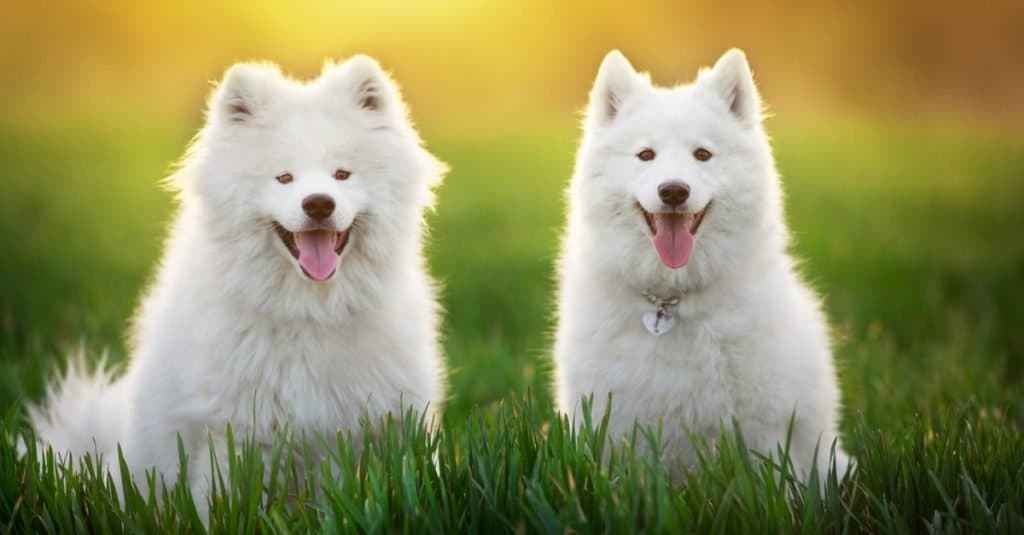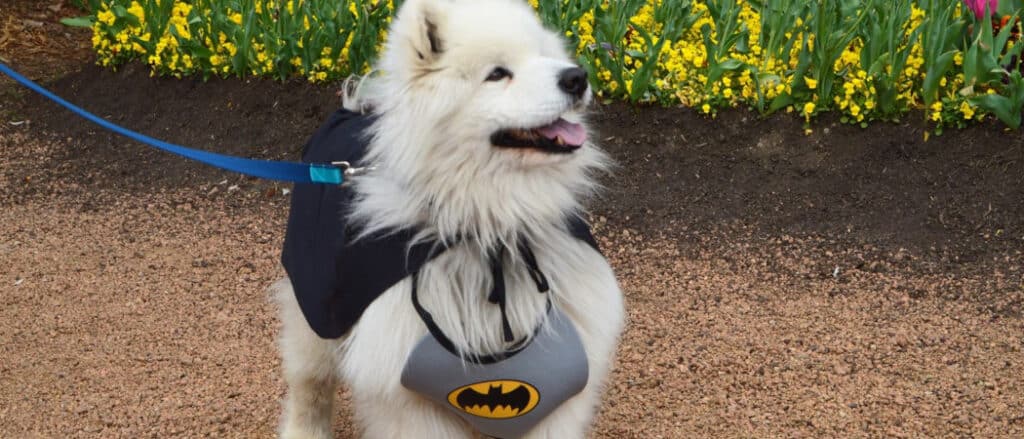Samoyed, a beloved dog species, is known for its fluffy white coat, smiling personality, curled tail, and cold-weather love. Friendly and personable, this intelligent breed thrives on human companionship.
A medium-sized dog, Samoyeds usually live between 12-15 years. As with any breed, however, Samoyeds are predisposed to certain health problems during their lives. What are the nine common health problems seen in Samoyed dogs?
1. Eye Problems

Samoyeds are susceptible to a number of eye problems.
©Roman Milavin/Shutterstock.com
Glaucoma
Unfortunately, Samoyeds are susceptible to a number of eye problems that can be either inherited or developed. Glaucoma, one of the most common eye problems seen in Samoyeds, can be painful and lead to blindness if left untreated.
Veterinarians will examine a dog’s eyes during its checkup, but pet owners need to regularly check for signs. Symptoms of glaucoma include squinting, watery eyes, bluing of the cornea (the clear front portion of the eye), and redness. In severe cases, the eye may look swollen.
Although glaucoma is painful, that discomfort is difficult for pet owners to discern. As glaucoma is considered a medical emergency, you need to get your pet to the vet’s office as soon as possible. Glaucoma can be treated with eye drops and/or surgery.
Cataracts
Samoyeds can inherit or develop either juvenile or, more likely, advanced-age cataracts. Symptoms of this condition include cloudiness in the eye’s pupil, inflammation surrounding the eye, and squinting. Treatment for cataracts in dogs requires surgery under general anesthesia where the lens is removed and replaced with plastic or acrylic.
Distichiasis
Samoyeds are also prone to distichiasis, a commonly inherited condition caused by extra hairs growing inside of the eyelid. Those hairs rub the surface of the eye, causing irritation. If this condition is untreated, the hairs can cause long-term eye pain and corneal ulcers. Treatment involves either removing the hairs by electrocautery, freezing, or a laser to destroy the follicles or by removing the affected portion of the eyelid altogether.
Retinal Dysplasia
This condition occurs when abnormal folds in the retina impair the dog’s vision. Retinal dysplasia (RD) can eventually lead to blindness. Often inherited, RD can be screened with a DNA test.
Progressive Retinal Atrophy (PRA)
PRA is another genetic disorder where the light sensors of the retina slowly die, causing blindness in youthful or middle-aged dogs. Again, early DNA screening for this condition is vital for Samoyed’s eye health.
2. Heart Problems

The Samoyed has a medium double coat that is white or cream.
©Ilya Barmin/Shutterstock.com
Atrial Septal Defect (ASD)
ASD is one of the genetic heart conditions to which the Samoyed can be predisposed. It is when a hole exists between the left and right atria of the heart prior to the puppy’s birth. The hole usually closes before birth, but if the hole is still present, it could cause abnormal heart blood flow and eventually heart failure. Although it is uncommon, the veterinarian will check for ASD immediately after birth. A veterinarian can treat ASD through a surgical procedure.
Aortic Stenosis
A narrowed opening in the aortic valve, aortic stenosis develops in older dogs. This condition can cause a heart murmur, which can be discerned in a physical, but aortic stenosis usually doesn’t cause major issues. If a Samoyed does have this condition, watch for lethargy, shortness of breath, coughing, or even collapsing. These symptoms could indicate a severe case of aortic stenosis which can be treated with merely restricting exercise and daily medication or surgery. Surgery includes the veterinarian placing a specialized balloon into the aorta.
Pulmonic Stenosis
Occurring more frequently in Samoyeds than in other dogs, pulmonic stenosis is a congenital defect of the valve between the heart’s right ventricle and the pulmonary artery. Because this defect causes reduced blood flow from the heart to the lungs, dogs may experience shortness of breath, abnormal heart rhythms, and even congestive heart failure. Veterinarians can use balloon valvuloplasty and/or beta-blockers such as atenolol to treat this condition.
3. Skeletal Problems

Hip dysplasia is common in Samoyeds and other medium to large-breed dogs.
©Evgeniia Shikhaleeva/Shutterstock.com
Hip or Elbow Dysplasia
A common skeletal disorder in dogs, hip dysplasia occurs when the ball and socket of the dog’s hip joint fit or develop improperly together. This defect leads to both bones rubbing against each other, causing the dog severe arthritic pain.
Symptoms of hip dysplasia include limping, a decrease in activity, decreased lower thigh muscle mass, enlarged shoulder mass, and extreme stiffness. PennHIP screening is a test that can detect a dog’s likelihood of developing hip dysplasia in the future.
Treatment for hip dysplasia includes anti-inflammatory medication and surgery. To minimize any stress on the dog’s hips, always strive to maintain the dog’s ideal weight.
Although less common (seen in only 2.2% of Samoyeds screened by The Orthopedic Foundation for Animals), Samoyeds can also develop dysplasia in their elbows. Symptoms include limping and abnormal gait, and treatment is the same as for hip dysplasia.
4. Bloat

Bloat is a life-threatening condition that requires emergency attention.
©iStock.com/Irina Tetereva
Gastric dilatation and volvulus, known as bloat, is a life-threatening emergency where the dog’s stomach twists within the abdomen. Bloat is more common in dogs with deep, narrow chests, so the Samoyed is more at risk than other breeds. The twisting cuts off the blood supply to the stomach (and sometimes the spleen), which is why immediate medical attention is critical.
Symptoms of bloat include retching or heaving with nothing coming out, acting extremely restless, an enlarged or full/tight abdomen, and drooling. Treatment — again, immediate treatment is key — includes prompt antacid medication and emergency surgery.
5. Uveodermatologic Syndrome

The Samoyed is an intelligent, gentle, and loyal dog.
©Kwadrat/Shutterstock.com
Uveodermatologic syndrome (UDS) is a skin and vision disease that occurs most commonly in Nordic breeds such as the Akita, Samoyed, Siberian Husky, and Shetland sheepdog, but can occur in any breed.
In this disease, the dog’s own immune system abnormally attacks melanin production. UDS causes skin lesions and lightening of the skin, inflammation in the eyes, and vision problems. Treatment includes corticosteroids (such as prednisone) and topical ointment or eye drops.
6. Metabolic System Problems

Samoyeds possess that “Sammie Smile” that proclaims their charm and friendliness.
©Nadezhda V. Kulagina/Shutterstock.com
Diabetes
Diabetes mellitus is a common disease in dogs, but Samoyeds are more predisposed to it than other breeds. Similar to a human’s Type I diabetes, chronic inflammation that develops in the pancreas causes this condition. Diabetes is diagnosed between 4-10 years of age, with an average age of seven for its onset.
Symptoms include increased eating, drinking, and urination. Weight loss is another significant symptom to watch for. Because diabetes disables the dog’s ability to regulate the metabolism of sugar, treatment includes daily insulin injections and a regulated diet. If caught early, Samoyeds with diabetes can enjoy the same life expectancy as other dog breeds.
Hypothyroidism
Hypothyroidism is when the thyroid gland fails to produce normal levels of the thyroid hormone., which influences metabolism, hair growth, weight regulation, and reproduction. Symptoms include hair loss, lethargy, weight gain, and infertility.
7. Samoyed Hereditary Glomerulopathy
Samoyed Hereditary Glomerulopathy (SHG), a genetic kidney disorder that affects the glomerulus (the kidney’s filter) is common in this breed. With SHG, blood proteins spill over into the urine.
Over time, this destruction of the glomerulus can lead to kidney failure, which usually happens at age five. A DNA test is available to detect SHG so that the pet owner can proactively begin treatment early. Although no specific cure exists for SHG, some ACE-inhibitor medications and protein-restricted “kidney-friendly” diets may slow the disease’s progression.
8. Dental Disease

Dental disease is the most common chronic problem in all pets.
©iStock.com/Roman Bjuty
Affecting 80% of all dogs by age two, dental disease is prevalent in Samoyeds. They are more prone to tooth problems than other dogs due to a hereditary tooth enamel disorder.
Autosomal recessive amelogenesis imperfecta (ARAI), also known as familial enamel hypoplasia (FEH), is a hereditary tooth enamel disorder that presents in Samoyeds. FEH is often first noticed in this breed when the permanent teeth come in, around six months of age. The permanent teeth appear normal, but the absence of an outer enamel layer lends itself to some nasty effects.
Some of these include tooth discoloration, sensitivity, premature wear, dental caries (bacterial infections), pulp exposure, tartar buildup, gingivitis, and periodontitis. Foul-smelling breath is common, and the disease can lead to gum recession and tooth loss. Treatment includes bonding the enamel, but the best and least expensive way to mitigate the condition’s effects is to clean (or have someone else clean) your Samoyed’s teeth regularly.
9. Obesity

Obesity is a common problem in all breeds, including the Samoyed.
©iStock.com/GJQuinlan
Samoyeds are prone to obesity. Like most dogs, Samoyeds need plenty of activity on a daily basis. Obesity is a huge problem, and in fact, the latest data from The American Kennel Club reveals that 56% of dogs in the U.S. are overweight or obese.
Dr. Ernie Ward, DVM, CVFT, and founder of the Association for Pet Obesity Prevention (APOP) says that owners “normalize” an overweight pet. He calls this the “fat pet gap,” which is the dissonance between what we humans think a dog should look like and what a healthy dog’s body actually looks like.
Ward and other veterinarians claim that obesity is our pets’ biggest health threat. Just as in humans, obesity can lead to and contribute to more serious health problems. Obesity in dogs is a major factor contributing to arthritis, chronic kidney disease, bladder and urinary infections, liver disease, low thyroid, diabetes, heart failure, high blood pressure, and cancer.
Causes of Obesity
Causes of obesity in dogs are overfeeding, a maturing dog, lack of exercise, genetic predisposition, some medications, neutering and spaying, and the owner’s denial of the dog’s condition. Symptoms of obesity include (obviously) weight gain, barely visible waistline, no palpable ribcage, excess body fat, lethargy, lack of mobility, and difficulty breathing, among others.
For 95% of dogs — including the Samoyed, the “standing test” is a good way to judge your dog’s weight status. Get to floor level and look at your dog from the side to tell if its stomach is sagging. Then, look at it from above. You should see an hourglass indentation in front of the hips. The dog’s chest should extend outward, and its waist should taper inward, making an hourglass.
Treating Obesity
Treating dog obesity is crucial, and it’s not difficult to figure out the two biggest remedies: food and exercise. Food is the chief factor, and it’s the more difficult to discern. You shouldn’t necessarily portion your dog’s food by the bag’s recommendations because they do not factor in a more sedentary dog or one that has been spayed or neutered.
Consult with your vet to figure out your Samoyeds dietary needs, and don’t be afraid of all “people food.” Feed them lean protein like chicken, turkey, fish, and eggs and fresh vegetables such as Brussels sprouts, broccoli, cauliflower, kale, cabbage, and spinach for fiber. Again, check with your vet if you have any concerns.
As far as exercise, Samoyeds (and most dogs) need a minimum of 40 minutes of exercise (ideally 20 minutes, twice a day) daily. A long walk with your dog will do wonders to improve physical and mental health for you both.
Ready to discover the top 10 cutest dog breeds in the entire world?
How about the fastest dogs, the largest dogs and those that are -- quite frankly -- just the kindest dogs on the planet? Each day, AZ Animals sends out lists just like this to our thousands of email subscribers. And the best part? It's FREE. Join today by entering your email below.
Thank you for reading! Have some feedback for us? Contact the AZ Animals editorial team.








